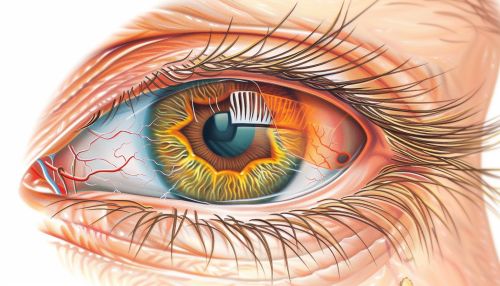Vision
Introduction
Vision is the process by which organisms interpret their surroundings using light. It involves the detection of light by the eyes, the conversion of this light into neural signals, and the interpretation of these signals by the brain. Vision is a complex and multifaceted sense that is crucial for many aspects of life, including navigation, communication, and survival.
Anatomy of the Eye
The eye is a sophisticated organ composed of several structures that work together to capture and process light. The main components of the eye include the cornea, lens, retina, and optic nerve.
Cornea
The cornea is the transparent, dome-shaped surface that covers the front of the eye. It functions as the eye's primary refractive surface, bending light to help focus it onto the retina.
Lens
The lens is a flexible, transparent structure located behind the cornea. It fine-tunes the focus of light onto the retina by changing its shape, a process known as accommodation.
Retina
The retina is a thin layer of tissue at the back of the eye that contains photoreceptor cells. These cells, known as rods and cones, detect light and convert it into electrical signals. Rods are responsible for vision in low light conditions, while cones are responsible for color vision and visual acuity.
Optic Nerve
The optic nerve transmits the electrical signals from the retina to the brain. It is composed of the axons of retinal ganglion cells and connects the eye to the visual cortex in the brain.


Visual Processing
Visual processing involves several stages, from the initial detection of light by the photoreceptors to the interpretation of visual information by the brain.
Phototransduction
Phototransduction is the process by which photoreceptor cells in the retina convert light into electrical signals. This process begins when photons of light are absorbed by photopigments in the rods and cones, causing a change in the photopigment's structure. This change triggers a cascade of biochemical reactions that result in the generation of an electrical signal.
Signal Transmission
The electrical signals generated by the photoreceptors are transmitted to bipolar cells, which in turn relay the signals to ganglion cells. The axons of the ganglion cells form the optic nerve, which carries the signals to the brain.
Visual Cortex
The visual cortex is the part of the brain responsible for processing visual information. It is located in the occipital lobe and is divided into several regions, each of which processes different aspects of vision, such as motion, color, and depth.
Color Vision
Color vision is the ability to perceive differences in the wavelength of light, which we interpret as different colors. This ability is primarily mediated by the cone photoreceptors in the retina.
Types of Cones
Humans have three types of cones, each sensitive to a different range of wavelengths: short-wavelength (S) cones, medium-wavelength (M) cones, and long-wavelength (L) cones. The combination of signals from these three types of cones allows us to perceive a wide range of colors.
Color Perception
Color perception is influenced by several factors, including the spectral composition of the light source, the reflectance properties of objects, and the context in which the colors are viewed. The brain integrates these factors to produce the perception of color.
Depth Perception
Depth perception is the ability to perceive the distance of objects in the environment. It is achieved through a combination of monocular and binocular cues.
Monocular Cues
Monocular cues are depth cues that can be perceived with one eye. They include relative size, interposition, linear perspective, and texture gradient.
Binocular Cues
Binocular cues require both eyes and include retinal disparity and convergence. Retinal disparity refers to the slight difference in the images projected onto each retina, which the brain uses to calculate depth. Convergence refers to the inward movement of the eyes when focusing on a close object.
Visual Disorders
Visual disorders can affect any part of the visual system, from the eye to the brain. Some common visual disorders include myopia, hyperopia, astigmatism, and cataracts.
Myopia
Myopia, or nearsightedness, is a condition in which distant objects appear blurry because the eye's lens focuses light in front of the retina.
Hyperopia
Hyperopia, or farsightedness, is a condition in which close objects appear blurry because the eye's lens focuses light behind the retina.
Astigmatism
Astigmatism is a condition in which the cornea or lens has an irregular shape, causing distorted vision.
Cataracts
Cataracts are a clouding of the lens, leading to decreased vision. They are often age-related but can also result from injury or disease.
